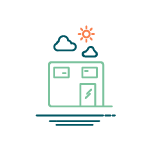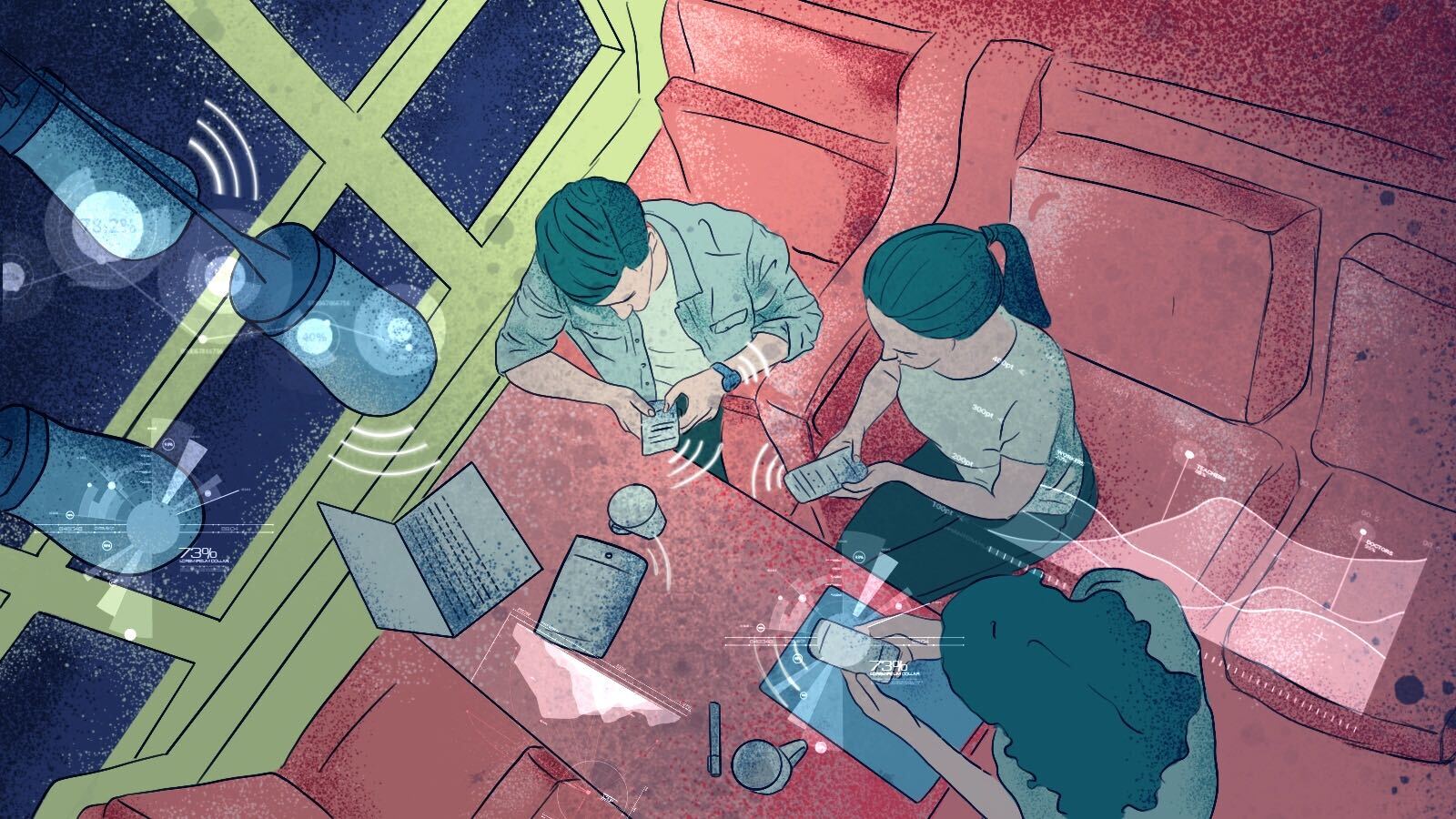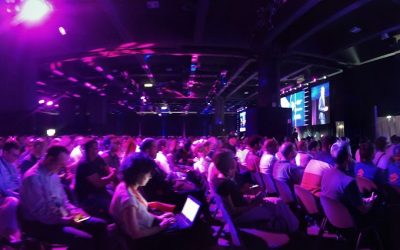Post- Covid Keywords: Rethink, transform and increase flexibility. Covid-19 Tech Index, a study released by IDC, foresees a dramatic decrease in IT spending due to the pandemic. However, IoT and AI will be growing exponentially. The trait d’union will be innovation and the capacity of IoT to collect large amounts of data, to develop high-value and public use services.
IoT represents a vast ecosystem of interconnected tech and objects, developed to make sense of the information that surrounds us. Mostly invisible to the human eye, sensors are functional to analyze the world and foster the AI.
IoT, enabling technology in unlimited possible situations. From Smart City solutions that can help optimize traffic through intelligent infrastructures to building-related ones that can monitor consumption parameters and control data of separate building rooms. IoT technology can detect if a desk is occupied within offices and conference rooms or connect physical objects and smart appliances to the internet and other devices and make our houses 100% Smart.
No matter the point of view, post-Covid evolution meets and “clashes” with this tech. Following the emergency and the shift in life and work dynamics, it’s a must for organizations to reconsider their workspace strategies.
Social distancing and Remote working could become the new normal and as a result, workspaces will have to be remodeled using technologies that allow a more effective environment optimization.
The short and long-term effects of the pandemic will be a challenge for construction reorganization—buildings, offices, and homes should be reconfigured—and for the concept of city itself.
For a multitude of reasons, the emergency is a chance to accelerate digital transformation processes that had already started in diverse areas of society, as well as the catalyst for the diffusion of emerging technologies, currently crucial for the recovery.
When countries re-emerge from lockdowns, the general IoT market will be in a unique state of grace, thanks to its fundamental role in most of the sectors of interest.
Smart Office and Smar Building: IoT makeovers
Current social distancing laws considered, it is estimated that half of the general workforce is already back to working from the physical office. Space will not be reduced, on the contrary, most likely more space, and specifically wider surfaces per number of people might be needed, as well as a redesign of massive open space desks.
We will more than likely transition from the familiar open space to modular space: a multi-space based on the number of people and their needs, to reconfigure when needed. Work Areas will be rethought hybridly between physical and virtual. Adjustable tables and stools, reservable and mobile desks; shielded and silent areas to focus, wider spaces dedicated to videoconferences, essential to coordinate dispersed teams.
Sliding walls and mobile panels to set up adaptive spaces and the ultimate safety warranty against the possible spread of contagion: automatic doors to replace handled ones. Not just an interior design makeover but a makeover centered around business function:
A shared space and a space for sharing, and moments to reflect, based on three keywords: Flexibility, Fluidity, and Safety.
This new mindset will lead to a natural transformation of construction towards environments focused on comfort, with built-in remote working areas. The need for workspace remodeling, sustainability, and cost management aimed at reducing fixed costs will merge. Dècor manufacturers can embed sensors in their products, thanks to technological development, turning chairs, tables, and desks SMART.
Tech development is also directly responsible for the rapid expansion of the furnishing design market. Sensors, encapsulated in desks, conference rooms, and lighting increase the efficiency of these objects, and make it also possible to analyze subsequently generated data. For example, if the sensors detect a scarce usage of a specific conference room, the building manager may consider converting it to office space or allocate it to workstations.
Potentially we can reserve a desk, a conference room, or other spaces of interest and as a direct result boost the office’s performance rate while optimizing space utilization and consumption of resources.
In post-lockdown, the goal will be creating safer workspaces for employees as well as for visitors. Employers and building managers are already implementing a series of solutions aimed at supporting their employee’s health and wellbeing.
Smart Home: IoT applications
The domestic environment went through a transformation as well, adapting its spaces with specific functionalities. The very way we live and inhabit changed: bedrooms, living rooms, and kitchens will turn into adaptive spaces at certain times of the day becoming places to study, virtual meeting points, actual offices, and even temporary gyms. So flexible and multifunctional spaces are the answer, once again thanks to a modular design, with its lightweight materials, easy to assemble and disassemble.
These are all new opportunities to turn common houses into a safer and more efficient Smart Home.
Many devices are tailor-made to improve our way of life. Intelligent fridges that can sense an empty compartment and place an order online. Hubs that connect to other appliances such as Amazon Echo or smart thermostats and plugs to optimize energy consumption levels and again lamps that can automatically regulate light levels in different moments of the day
Fresco Frigo is an example of practical application. The Italian startup created an ad-hoc solution to support apartment building residents in their purchase of food supplies. The company had five smart fridges installed in the residential complex “Social Village Cascina Merlata” in Milan. These fridges were meant to satisfy the needs of more than 900 residents in the 397 apartments of the complex of buildings. The residents can view products from local shops out of the frontal window of the fridge, unlock and open the fridge via Mobile App, choose the products and purchase the goods by simply closing the fridge door. The system then processes the transaction and charges the cost of the order.
Smart City: Urban Rebirth
If history teaches us that the way cities are built is directly linked to disease it’s only logical to suppose that work-life space transformations could turn this emergency into an opportunity for tech development. A unique chance to improve daily routine by acting directly on the living space, redesigned to adapt to newly discovered needs.
A golden age for IoT on an urban scale with accelerated production and riding the wave of general interest towards traceable, monitorable, and data collections solutions, for more efficient and generally better systems.
A Sole 24 Ore article states that before Covid-19, the Italian intelligent hardware market reached a value of 6.2 billion euros (2019). A growth rate of 1,2 billion (+24%) compared to the previous year.
The very idea of Smart City is being re-evaluated due to the emergency and post-pandemic needs. The new, more coherent definition is one of a Safe City, which goal is to slow down the fast-growing density of cities while providing safer spaces from a sanitary point of view.
Urban spaces and even buildings reconsidered in their design by applying the same concept used in offices and homes. It’s fundamental that the building’s life cycle, versatility, assembly, and disassembly potential is engineered beforehand, privileging a sustainable and biophilic design (akin to the natural environment) for preventive emission reduction.
In a temporary arch of a few weeks, the way people think and live spaces radically changed. Urban design was already in the process of transforming intermediate spaces: courtyards, loggias, gardens and condominium terraces, balconies, “windows on the city” that connect interiors to exteriors.
That functional mixitè promoted by environmental engineering for years will become possible: access to utility services such as schools, stores, services, and public spaces, Food & Beverage and green areas will have to be within 300 meters from our homes.
Imagining a decrease in our movements and a consequent reduction of environmental impact is possible with the aid of increasingly efficient technologies and the use of sensors and Artificial Intelligence.
The City of the future is a constellation of Ecotech neighborhoods continuously redrawing and spreading the city center into small aggregation areas reducing the need for motor vehicle use.
Four the major drivers that will guide the development of multi-central Smart Cities:

Sustainability
Sustainable infrastructure for transportation, energy, environment (water, green, and waste)

Resiliency
Resilient infrastructures, namely sensorized and governed, to resist environmental stress and large-scale events within cities

Accessibility
Accessible infrastructures for facilitated mobility and fixed & mobile communication networks

Inclusivity
Inclusive infrastructures, i.e. designed through listening mechanisms that involve citizens via participative processes on main urbanistic city choices
From Product to Service
Thus, the 2020 sanitary emergency resulted in a series of needs: the demand for a strong reorganization, the urge for sanitization due to health safety, and the demand for more connected services, in spaces that overlapped and will overlap more frequently in the future.
This shift in functions inevitably paved the way for a transition from product to service, especially towards the concept of connected service that enables the communication between interiors and exteriors. This is where the bond between demand and offer is solidified through IoT, which transforms common objects into full-fledged services.
Many companies have straight-line revenues, meaning they are fully tied to the production of goods: a given quantity of produced goods corresponds to an equivalent revenue.
But this equation is no longer valid in a service economy. New products and services are flooding our homes, often becoming essential. We are witnessing new business and non-linear income models, based on a “Pay Per Use” or “Pay As You Go” subscription logic.
In one word: Servitization.
But what is it and why is it important?
How to take advantage and make sense of the data generated by the new connected services?
How to benefit from it to increase cross-selling potential?
The ultimate digital transformation that can’t be dismissed.
We have been talking about all this on the occasion of the digital event “Smart Building 4.0: Design, Data& Technologies” —in collaboration with IoTItaly—with the company of major figures in the field.
In conclusion, the near future will be SMARTER —Smart Working, Smart Office, Smart Home, Smart Building and Smart City—intelligent, tech, and intrinsically linked to the service, thanks to the fast diffusion and implementation of new ways and approaches that skillfully mix man and machine in every possible area of daily life.
You might also like:
5G e IoT: the Fourth Industrial Revolution
Interlogica: IoT application in Smart working and Facility Management:
4Energy – Reduce energy waste and optimize your resources



